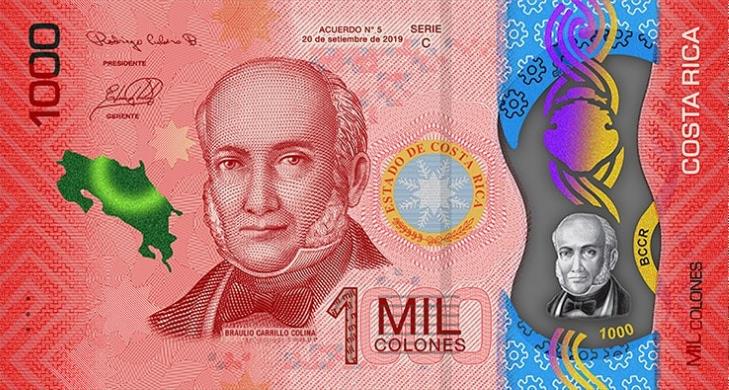Product Owner: Banco Central de Costa Rica
Banknote Denomination/s and Date of Issue
The new ₡10,000 and ₡1,000 polymer banknotes launched on 15th October 2021, joins the rest of the Guardian™ notes that are already in circulation.
When the transition to polymer began in 2010, the Costa Rican banknote family included four denominations, all of which were the same size. The uniform size made differentiation between the notes difficult for visually impaired people. An ancillary advantage of the move to polymer is that the new notes are in different sizes and use varied, high contrast colours with updated security features.
The beautiful high contrast on each of the banknotes speaks of the history and culture of Costa Rica. The ₡1,000 banknote includes Barulio Carrillo Hill while the main motif is the Shield of the State of Costa Rica. The reverse of the note meanwhile pays tribute to the Costa Rican eco system, the dry forest with Guanacaste Tree, Pitahaya and the White Tailed Deer. The note is predominantly in red.
The ₡10,000 meanwhile includes José Figueres Ferrer who served as the president of Costa Rica on 3 occasions, whilst the reverse of the note again highlights the Costa Rican eco-system featuring the rain forest, Three Toed Sloth and the Cup Mushroom Orchid. The ₡10,000 is predominantly in green.
Project Description
With the introduction of polymer banknotes in 2010. An in-depth study of the note was done, including analysing the durability, cost benefit ratio, security aspects, internal processing impact & the experiences of other countries.
Analysis by the BCCR also showed significant reduction in counterfeits. The bank has shared data which shows that between 2011 and 2021 no fake ₡1000 banknotes was detected, despite there being a very high counterfeits previously.
The completion of the polymer banknote series with the launch of ₡10,000 and ₡1,000 in 2021 showcased the long lasting benefits of polymer banknotes.
The obverse of the notes are adorned with important historical figures like Braulio Evaristo Carrillo Colina, Head of State of Costa Rica during two periods on the ₡1000, while the ₡10,000 hosts José Figueres Ferrer who served as the president of Costa Rica on 3 occasions. The reverse of the notes meanwhile highlights the Costa Rican eco system.
Security features on both notes seamlessly integrates into the beautiful high contrast banknotes.
Innovation and Uniqueness of Security Features
Both ₡10,000 and ₡1,000 polymer banknotes include large transparent windows with an image of Braulio Evaristo Carrillo Colina, on the ₡1,000 that changes colour. Further when the ₡1,000 note is tilted the coffee lead and the map of Costa Rica changes colour from pink to gold.
Meanwhile the ₡10,000 banknote follows same theme with José Figueres Ferrer image in the transparent window which changes colour when tilted.
The uniform size made differentiation between the notes difficult for visually impaired people. An ancillary advantage of the move to polymer is that the new notes are in different sizes and use varied, high contrast colours
Integration of historical or local content that is relevant to the country
concerned
The new polymer notes follows the same design theme with an important historical figure adorning the obverse of the notes whiles the Costa Rican eco-system is highlighted on the reverse.
The beautiful high contrast on each of the banknotes speaks of the history and culture of Costa Rica. The ₡1,000 banknote includes Barulio Carrillo Hill while the main motif is the Shield of the State of Costa Rica. The reverse of the note meanwhile pay tribute to the Costa Rican eco system, the dry forest with Guanacaste Tree, Pitahaya and the White Tailed Deer. The note is predominantly in red.
The ₡10,000 meanwhile includes José Figueres Ferrer who served as the president of Costa Rica on 3 occasions, whilst the reverse of the note again highlights the Costa Rican eco-system featuring the rain forest, Three Toed Sloth and the Cup Mushroom Orchid. The ₡10,000 is predominantly in green.
Effectiveness of the integration of security features into the banknote
The new polymer notes have retained the key design, characters, motifs, colours and sizes from previous paper versions, but with amendments to their design and the incorporation of new security measures that are possibly only with polymer substrate. Both denominations incorporate a transparent window that is wider and more visible.
The Kinegram Review® foil stripe supplied by Kurz is applied over the complex transparent windows of both notes. Meanwhile the ₡10,000 banknote with José Figueres Ferrer image in the transparent window changes colour when tilted which is the same with the ₡1,000 note of Braulio Evaristo Carrillo.
The uniform size made differentiation between the notes difficult for visually impaired people. An ancillary advantage of the move to polymer is that the new notes are in different sizes and use varied, high contrast colours
Aesthetic appeal and overall design of the banknote or banknote series
These beautiful high contrast banknotes incorporate colourful design themes, which are visually striking. The security features seamlessly integrate and highlights the designs, which is a perfect construction of a polymer banknote.
Banco Central de Costa Rica uses the obverse of the note to depict important historical features whilst the reverse of the notes highlight the biodiversity of Costa Rica. This would be the overall design theme across the polymer banknote series completed with the issuance of ₡1000, and ₡10,000 in 2021.

